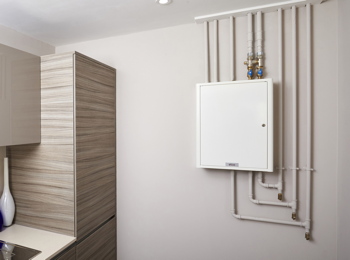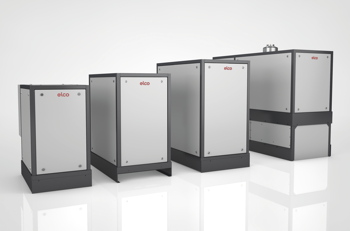A modern solution for the energy trilemma

Mark Ferris, discusses the benefits of district heating systems and how to effectively incorporate CHP and HIUs to provide an affordable, environmental and diverse heat source.
CIBSE’s Code of Practice for Heat Networks (2015), recognised the technology as an important component in the UK’s future energy strategy. They were also highlighted as a possible option for addressing the ‘energy trilemma’ by helping to reduce greenhouse gas emissions; improve energy security by diversifying energy sources; and supply heat that could reduce fuel poverty.
In 2018, heat networks continue to be a major driver in the commercial heating market, especially in multi-storey residential properties. However, planning a successful district heating network is not always clear-cut, and there are plenty of critical design considerations.
In its simplest form, district heating comprises a central heat source (such as gas boilers, CHP unit or both), which is networked to a group of flats or homes. A networked heating substation, or heat interface unit, draws heat from the central plant via a low-temperature hot water (LTHW) loop. It then delivers all the functions of a combiboiler, with both heating and instantaneous domestic hot water (DHW) supplied to a property at temperatures and flow rates that suit user demand. Such a scheme offers unrivalled economies of scale, as the output of the centralised system is designed to be lower than the aggregated output of individual heat interface units.
The energy trilemma
So, how does a network heating system reduce greenhouse gas emissions? It all comes down to the diversity factor that can be applied to the total energy requirement (which allows for the fact that residents won’t all call for heat at the same time).
 |
|
The HIU is one of the most important components of a district heating scheme |
Take a residential block of apartments as an example. The heating demand for one apartment might only be 4-5kW under design conditions and, at light load running, can be as little as 15% of design (i.e. less than 1kW). If you consider this scenario with a 30kW combi boiler, the central heating demand is substantially below the turndown capability of many models.
Compare this to a network heating system with heat interface units and these issues can be eliminated. The HIU will draw heat from the primary system via a plate heat exchanger and deliver the required demand, even at light load conditions. Plus, with the latest units having higher outputs (up to 130kW DHW) and virtually infinite turndowns, they also provide even more stability of DHW temperature at both high and low flow rates.
The second benefit of a district heating system is the ability to diversify energy sources, and combined heat and power (CHP) units have become a popular strategy. In such a scheme, it is more than likely the CHP will be designed to be heat-led, i.e. maximise the supply of heating and hot water to the apartments. In this instance, a CHP installation can be deemed successful if the system is designed to utilise 100% of the heat generated.
However, it is vital to establish a daily load profile and base heating load for the building, which can then be used to calculate the size of a CHP unit. Once the correct size of unit has been established, it is best to target a run time of 14-17 hours per day (as recommended in CIBSE AM12).
Once a CHP is sized correctly,it needs to maintain optimum running conditions. As a result, there is often a need to incorporate a large thermal store, as it allows the system to cope with heat demands greater than the maximum output of the CHP. Conversely, it also enables heat demands lower than the minimum turndown to be met, further reducing the use of boilers and increasing CHP operating times. In both scenarios, a CHP unit can function at full output rather than at part-load conditions, improving efficiency and reducing operating costs while providing ‘good value’ heat.
 |
|
CHP units from Elco: CHP is being used within district heating systems |
The HIU
The HIU is a key component of any district heating network. It provides occupants with controlover their heating and hot water and ensures hydraulic balance.
However, not all HIUs are equal. Inadequate control can cause less heat to be taken out of the primary system, making it difficult to obtain a high Delta T. This problem can be compounded if the primary system contains a CHP unit, as this technology has a sensitivity to return temperatures, which can affect run time and overall efficiency.
A successful district heating network requires careful design, especially in terms of sizing a CHP unit, thermal store and the overall control strategies. However, when these elements are aligned, greenhouse gas emissions are reduced, energy sources are diversified and the supply of heat is deemed to be good value. If adopted, heat networks will surely form a significant part of a low carbon energy infrastructure in the UK for decades to come.
Mark Ferris is specification manager at Elco Heating Solutions








